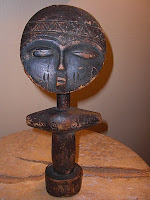Welcome to the (African) Dollhouse
In "the olden days," in Sub-Saharan Africa, there was a larger variety of
dolls than nowadays, of which I'll describe a few. They used to be made of natural materials, such as wood, earth, or even weeds.
 |
| Ashanti doll |
The Ashanti Ghana
 |
| Moundang doll |
The Mandara mountains Moundang doll, from Northern Cameroon , made of volcanic
rock, and decorated with tiny beads. This is the one which arguably least
resembles the traditional European-style doll (photo right).
Fali dolls from northern Cameroon
* male doll made of a corncob, decorated with cowry shells, European beads, leather strips,
with a cotton skirt;
 |
| Senegalese doll |
 |
| Ngongui doll |
From my own doll collection are a few more photos: a
Senegalese rag doll, a doll with a straw head covering, and a plastic doll wearing Martinique 's madras clothes
(African diaspora), and an African "Raggedy Ann" style.

 |
| Doll from Martinique |
 |
A few links to sites that show African dolls:
Wikipedia entry: http://en.wikipedia.org/wiki/African_dolls








Comments
Post a Comment
Please let me know your thoughts and questions. Also, if you feel that anything is incorrect, please let me know.
I need to moderate the comments, as in recent years there has been a spike in spam.